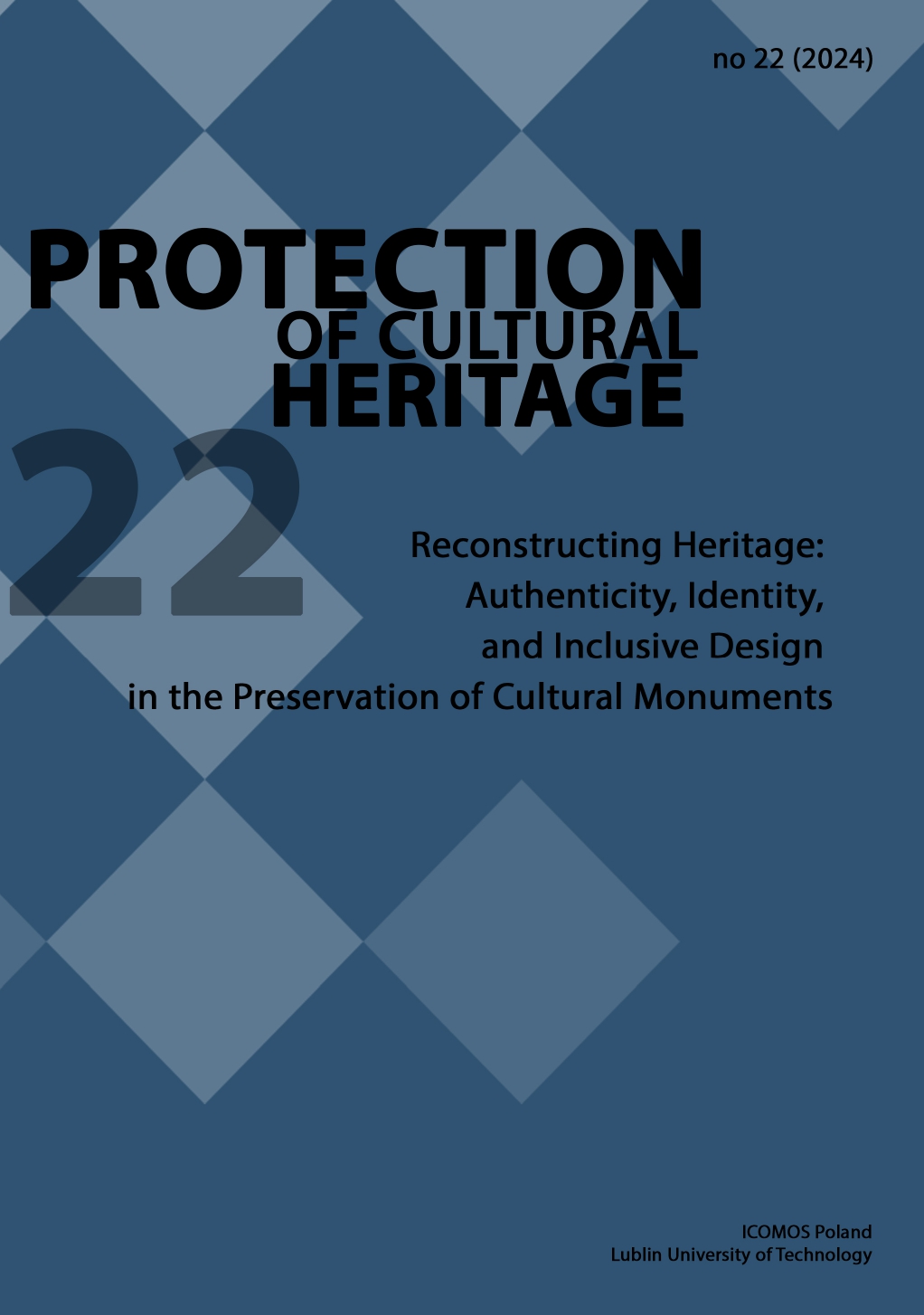"Otwarta" Karta Wenecka
Wnioski z różnych interpretacji i tłumaczeń art. 9 Karty
Claudine Houbart
c.houbart@uliege.beUniversity of Liège (Belgium), Faculty of Architecture (Belgia)
https://orcid.org/0000-0002-7037-5815
Stéphane Dawans
University of Liège (Belgium), Faculty of Architecture (Belgia)
Abstrakt
Artykuł stanowi wkład w inicjatywę badawczą mającą na celu wypełnienie istotnej luki w historiografii Karty Weneckiej: jej tłumaczeń. Pierwotnie skomponowana w języku francuskim, wkrótce po powstaniu Karta została przetłumaczona na język angielski, hiszpański i rosyjski, a wersje francuska i angielska służyły jako podstawa dla kolejnych tłumaczeń. Jednak pobieżne zbadanie tych wersji ujawnia znaczące rozbieżności. Widać wyraźnie odejście od koncepcji Umberto Eco o tłumaczeniach „mówiących prawie to samo”. Różnice językowe dały początek różnym interpretacjom w czasie i w różnych regionach geograficznych, co sugeruje, że Karta Wenecka działała bardziej jako „otwarte dzieło” niż sztywno uniwersalny standard. Powstrzymując się od bezpośredniego angażowania we współczesne znaczenie Karty, niniejszy artykuł zagłębia się w badanie potencjalnego znaczenia tłumaczeń i interpretacji, koncentrując się na jednej z najbardziej kontrowersyjnych sekcji Karty: Artykule 9, a w szczególności na pojęciach „odrębności” i „współczesnej pieczęci”. Refleksje te są kontekstualizowane poprzez spostrzeżenia Umberto Eco na temat natury „dzieła otwartego” i zawiłości procesu tłumaczenia.
Słowa kluczowe:
Karta Wenecka, uniwersalizm, tłumaczenie, otwarta pracaBibliografia
Brandi, C. (2005). Theory of Restoration, edited by Giuseppe Basile, translated by Cynthia Rockwell. Rome: Istituto Centrale per il Restauro, Nardini editore.
Google Scholar
Cohen, J. (1966). Structure du langage poétique. Paris : Flammarion.
Google Scholar
Eco, U. (2003). Dire presque la même chose. Paris : Grasset, 2003.
Google Scholar
Groupe µ (1977). Rhétorique de la poésie: Lecture linéaire, lecture tabulaire. Brussels : Éditions complexe.
Google Scholar
His Royal Highness the Prince of Wales (2009). Foreword. In: The Venice Charter Revisited: Modernism, Conservation and Tradition in the 21st Century (xiii-xiv). Newcastle upon Tyne: Cambridge Scholars Publishing.
Google Scholar
Houbart, C. (2014). Deconsecrating a doctrinal monument: Raymond M. Lemaire (1921-1997) and the Revisions of the Venice Charter. Change Over Time, 4(2), 218-243.
Google Scholar
Houbart C. (2018) The Great Beguinage of Leuven: An Early Challenge for the Venice Charter. Opus, Nuova serie (2), 105-128.
Google Scholar
Houbart, C. (2024), The Evolution of Urban Heritage Conservation and the Role of Raymond Lemaire. Abingdon & New York: Routledge.
Google Scholar
ICOMOS (1965). International Charter for the Conservation and Restoration of Monuments and Sites (Venice Charter, 1964).
Google Scholar
ICOMOS (1978). Summary Report of the Vth General Assembly of ICOMOS, Moscou-Souzdal, 22–24 May 1978. Available at: https://www.icomos.org/public/publications/1978-Moscou.pdf.
Google Scholar
ICOMOS (1989). Charta von Venedig neu übersetzt. Denkmalschutz Informationen, XIII(3), 2‑6.
Google Scholar
Iser W. (1978). The Act of Reading: a Theory of Aesthetic Response. Baltimore: John Hopkins University Press.
Google Scholar
Jakobson, R. (1960). Closing Statement: Linguistics and Poetics. In: Style in Language (350-377): Cambridge: Massachusetts Institute of Technology Press.
Google Scholar
Jencks, C. (1988). The Prince, The Architects and New Wave Monarchy. New York: Rizzoli.
Google Scholar
Kovács, E. (2005). The Venice Charter 1964—2004—2044? : The fortieth anniversary, Budapest-Pécs, Hungary, May 22-27, 2004. Hungarian National Committee of ICOMOS.
Google Scholar
Lagneau, J.-F., dir. (2019). Retour à l’esprit de la Charte de Venise. Paris : ICOMOS France.
Google Scholar
Lemaire, R. M. (1976). La mémoire et la continuité. Louvain, Archive of the R.M. Lemaire International Centre for Conservation.
Google Scholar
Lemaire, R. M. (1995). Faut-il revoir la Charte de Venise. Restauro, La Carta di Venezia trenta anni dopo: incontro internazionale di studio, 24 (131-132), 5-9.
Google Scholar
Lyons, D. (1999). Open Texture and the Possibility of Legal Interpretation. Law and Philosophy, 18(3), 297-309.
Google Scholar
Parent, M. (1976). Problèmes de la restauration avec l’environnement sociologique et culturel. Les monuments historiques de la France, hors-série, ‘Les restaurations françaises et la Charte de Venise’, 10-19.
Google Scholar
Peterson, C. E. (1965). The monumental patrimony. American Institute of Architects Journal 43(1), 57-59.
Google Scholar
Riffaterre, M. (1978). Semiotics of poetry. Bloomington: Indiana University Press.
Google Scholar
Rodwell, D. (2022). Inhabited Historic Cities, Urban Heritage, and dissonances at the heart of the World Heritage system. European journal of postclassical archaeologies, 12, 291 352.
Google Scholar
Smith, L. (2006). Uses of Heritage. Abingdon & New York: Routledge.
Google Scholar
Szmygin, B., & Skoczylas, O. (2021). Factors shaping the Venice Charter and its usefulness – on the example of heritage protection in Poland. Teka Komisji Architektury, Urbanistyki i Studiów Krajobrazowych, 17(3), Article 3. https://doi.org/10.35784/teka.2861
Google Scholar
Tomaszewski, A. (2005). Intellectual context of monuments and sites in their setting. In: 15th ICOMOS General Assembly and International Symposium: ‘Monuments and sites in their setting - conserving cultural heritage in changing townscapes and landscapes’, 17 – 21 oct 2005, Xi'an, China. Available at: https://openarchive.icomos.org/id/eprint/300/
Google Scholar
Wells, J.C. (2007). The plurality of truth in culture, context, and heritage: a (mostly) post-structuralist analysis of urban conservation charters. City & Time, 3(2).
Google Scholar
Wells, J.C. (2019). The Treatment of Historic Automobiles and Buildings. In: The Routledge Companion to Automobile Heritage, Culture, and Preservation (35-46). Routledge Handbooks Online.
Google Scholar
Autorzy
Claudine Houbartc.houbart@uliege.be
University of Liège (Belgium), Faculty of Architecture Belgia
https://orcid.org/0000-0002-7037-5815
Autorzy
Stéphane DawansUniversity of Liège (Belgium), Faculty of Architecture Belgia
Statystyki
Abstract views: 33PDF downloads: 17









